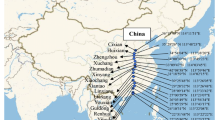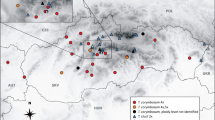Abstract
Ploidy level and geographical distribution were investigated in Japanese Lonicera caerulea L. Flow cytometric analysis revealed the presence of DNA diploid and DNA tetraploid plants in Japan. Chromosome observation confirmed that diploid and tetraploid plants showed 2n = 2x = 18 and 2n = 4x = 36, respectively. The DNA diploid populations were found only in lowland mires, Betsukai, Bekanbeushi, Kushiro and Kiritappu located in eastern Hokkaido. On the other hand, DNA tetraploid populations were distributed in a wide area of Hokkaido, and mainland of Japan. The habitats of DNA tetraploid plants were lowland to alpine region. The DNA content measurement with flow cytometry revealed significant differences in the relative DNA contents among DNA tetraploid populations. The relative DNA content within DNA tetraploid populations varied 1.157-fold at maximum, and might correlate with altitude indicating that DNA contents were smaller as altitude increases. The wide area of distribution in various environments of DNA tetraploid plants suggested the adaptability of the tetraploid plants. Although diploid and tetraploid populations were found, no triploid was detected, indicating crossing difficulty between diploid and tetraploid as confirmed by crossing experiment.






Similar content being viewed by others
References
Ammal EKJ, Saunders B (1952) Chromosome numbers in species of Lonicera. Kew Bull 7:539–541
Anetai M, Ogawa H, Hayashi T, Aoyagi M, Chida M, Muraki M, Yasuda C, Yabunaka T, Akino S, Yano S (1996) Studies on wild plants traditionally used by the Ainu people (PartI): contents of vitamins A, C and E in edible plants. Rep Hokkaido Inst Public Health 46:34–39 (in Japanese with English summary)
Ceccarelli M, Falistocco E, Cionini PG (1992) Variation of genome size and organization within hexaploid Festuca arundinacea. Theor Appl Genet 83:273–278
Chaovanalikit A, Thompson MM, Wrolstad RE (2004) Characterization and quantification of anthocyanins and polyphenolics in blue honeysuckle (Lonicera caerulea L.). J Agric Food Chem 52:848–852
Creber HMC, Davies MS, Francis D, Walker HD (1994) Variation in DNA C value in natural populations of Dactylis glomerata L. New Phytol 128:555–561
Evans GM, Durrant A, Rees H (1966) Associated nuclear changes in the induction of flax genotrophs. Nature 212:697–699
Greilhuber J, Doležel J, Lysák MA, Bennett MD (2005) The origin, evolution and proposed stabilization of terms ‘Genome size’ and ‘C-value’ to describe nuclear DNA contents. Ann Bot 95:255–260
Haig D, Westoby M (1991) Genomic imprinting in endosperm: its effect on seed development in crosses between species, and between different ploidies of the same species, and its implications for the evolution of apomixes. Philos Trans R Soc Lond B 333:1–13
Hara H (1983) Section 3. Caeruleae. In: Ginkgoana, Contributions to the flora of Asia and the pacific region No. 5, a revision of Caprifoliaceae of Japan with reference to allied plants in other districts and the Adoxaceae. Academia Scientific Book Inc., Tokyo, pp 79–84
Knight CA, Molinari NA, Petrov DA (2005) The large genome constraint hypothesis: evolution, ecology and phenotype. Ann Bot 95:177–190
Kubátová B, Trávníček P, Bastlová D, Čurn V, Jarolímová V, Suda J (2008) DNA ploidy-level variation in native and invasive populations of Lythrum salicaria at a large geographical scale. J Biogeogr 35:167–176
Leitch IJ, Bennett MD (2004) Genome downsizing in polyploid plants. Biol J Linn Soc 82:651–663
Lewis WH (1980) Polyploidy in species populations. In: Lewis WH (ed) Polyploidy: biological relevance. Plenum Press, New York, pp 103–147
Mishiba K, Ando T, Mii M, Watanabe H, Kokubun H, Hashimoto G, Marchesi E (2000) Nuclear DNA content as an index character discriminating taxa in the genus Petunia sensu Jussieu (Solanaceae). Ann Bot 85:665–673
Murray BG (2005) When does intraspecific C-value variation become taxonomically significant? Ann Bot 95:119–125
Naugžemys D, Žilinskaitė S, Denkovskij J, Patamsytė J, Literskis J, Žvingila D (2007) RAPD based study of genetic variation and relationships among Lonicera germplasm accessions. Biologija 53:34–39
Plekhanova MN (2000) Blue honeysuckle (Lonicera caerulea L.)—a new commercial berry crop for temperate climate: genetic resources and breeding. Acta Hortic 538:159–164
Plekhanova MN, Solovyeva LV, Mochalova OV (1992) Chromosome numbers and distribution area of Lonicera subsect. Caeruleae (Caprifoliaceae). Botanicheskii Zhurnal 77:1–11 (in Russian with English summary)
Ramsey J, Schemske DW (1998) Pathways, mechanisms, and rates of polyploid formation in flowering plants. Annu Rev Ecol Syst 29:467–501
Ramsey J, Schemske DW (2002) Neopolyploidy in flowering plants. Annu Rev Ecol Syst 33:589–639
Reeves G, Francis D, Davies MS, Rogers HJ, Hodkinson TR (1998) Genome size is negatively correlated with altitude in natural populations of Dactylis glomerata. Ann Bot 82(Supplement A):99–105
Sahara K, Yoshido A, Kawamura N, Ohnuma A, Abe H, Mita K, Oshiki T, Shimada T, Asano S, Bando H, Yasukochi Y (2003) W-derived BAC probes as a new tool for identification of the W chromosome and its aberrations in Bombyx mori. Chromosoma 112:48–55
Sato T (1985) Hokkaido ni okeru Kurominouguisukagura·Keyonomi ni tuite (Lonicera caerulea var. emphyllocalyx and L. caerulea var. edulis in Hokkaido.). Wild Life Rep 2:47–51 (in Japanese)
Shibata F, Hizume M (2002) The identification and analysis of the sequences that allow the detection of Allium cepa chromosomes by GISH in the allodiploid A. wakegi. Chromosoma 111:184–191
Šmarda P, Bureš P (2006) Intraspecific DNA content variability in Festuca pallens on different geographical scales and ploidy levels. Ann Bot 98:665–678
Solovyeva LV, Plehanova MN (2003) Investigation of karyotype of the blue honeysuckle (Lonicera subsect. caeruleae, Caprifoliaceae). Cytol Genet 37:30–38
Suda J, Krahulcová A, Trávníček P, Krahulec F (2006) Ploidy level versus DNA ploidy level: an appeal for consistent terminology. Taxon 55:447–450
Suda J, Weiss-Schneeweiss H, Tribsch A, Schneeweiss GM, Trávníček P, Schönswetter P (2007) Complex distribution patterns of di-, tetra-, and hexaploid cytotypes in the European high mountain plant Senecio carniolicus (Asteraceae). Am J Bot 94:1391–1401
Sugiyama S, Yamada T (2003) Variation in nuclear DNA content in natural populations of orchardgrass (Dactylis glomerata L.) in the eastern part of Hokkaido, Japan. Grassland Sci 49:129–133
Terahara N, Sakanashi T, Tsukui A (1993) Anthocyanins from the berries of Haskaap, Lonicera caerulea L. J Home Econ Jpn 44:197–201
Thompson MM, Chaovanalikit A (2003) Preliminary observations on adaptation and nutraceutical values of blue honeysuckle (Lonicera caerulea) in Oregon, USA. Acta Hortic 626:65–72
Acknowledgments
The authors thank Drs. K. Sahara and F. Shibata for their valuable suggestions on chromosome observation. We also thank to Drs. T. Sato and Y. Wakita (Hokkaido Forestry Research Institute) and “Nikko Botanical Garden”, Graduate School of Science, the University of Tokyo, and Shibetsu Town for providing plant materials of Lonicera caerulea. We are very grateful to A. Takai (Kiritappu Wetland Center) and T. Shibuya (Akkeshi Waterfowl Observation Center) for their helps in collecting the plant materials. We gratefully acknowledge Prof. H. Nakashima, H. Hori, H. Tamura, M. Ikuta, H. Nakano, S. Takamushi and T. Takahashi for the technical assistances on the University farms. This work was supported in part by grants from Takeda Scientific foundation, Grant-in-Aid for Scientific Research of Lake Akkeshi and Bekanbeushi Wetland, a Grant-in-Aid for Scientific Research from the Ministry of Education, Culture, Sports Science and Technology (MEXT), and Global COE Program “Establishment of Center for Integrated Field Environmental Science”, MEXT, Japan.
Author information
Authors and Affiliations
Corresponding author
Rights and permissions
About this article
Cite this article
Miyashita, T., Araki, H. & Hoshino, Y. Ploidy distribution and DNA content variations of Lonicera caerulea (Caprifoliaceae) in Japan. J Plant Res 124, 1–9 (2011). https://doi.org/10.1007/s10265-010-0341-6
Received:
Accepted:
Published:
Issue Date:
DOI: https://doi.org/10.1007/s10265-010-0341-6




